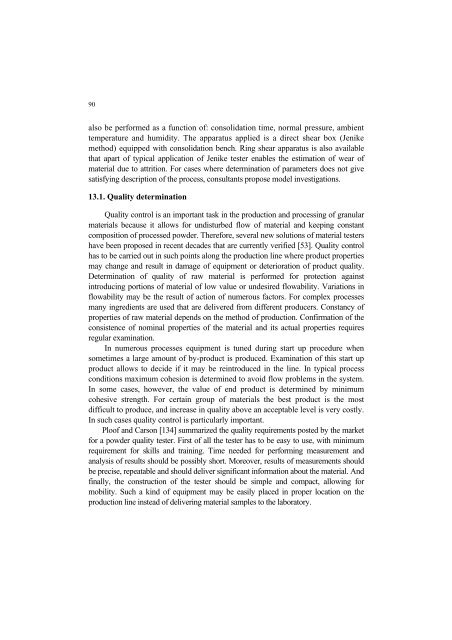Strona 2_redak - Instytut Agrofizyki im. Bohdana DobrzaÅskiego ...
Strona 2_redak - Instytut Agrofizyki im. Bohdana DobrzaÅskiego ...
Strona 2_redak - Instytut Agrofizyki im. Bohdana DobrzaÅskiego ...
Create successful ePaper yourself
Turn your PDF publications into a flip-book with our unique Google optimized e-Paper software.
90<br />
also be performed as a function of: consolidation t<strong>im</strong>e, normal pressure, ambient<br />
temperature and humidity. The apparatus applied is a direct shear box (Jenike<br />
method) equipped with consolidation bench. Ring shear apparatus is also available<br />
that apart of typical application of Jenike tester enables the est<strong>im</strong>ation of wear of<br />
material due to attrition. For cases where determination of parameters does not give<br />
satisfying description of the process, consultants propose model investigations.<br />
13.1. Quality determination<br />
Quality control is an <strong>im</strong>portant task in the production and processing of granular<br />
materials because it allows for undisturbed flow of material and keeping constant<br />
composition of processed powder. Therefore, several new solutions of material testers<br />
have been proposed in recent decades that are currently verified [53]. Quality control<br />
has to be carried out in such points along the production line where product properties<br />
may change and result in damage of equipment or deterioration of product quality.<br />
Determination of quality of raw material is performed for protection against<br />
introducing portions of material of low value or undesired flowability. Variations in<br />
flowability may be the result of action of numerous factors. For complex processes<br />
many ingredients are used that are delivered from different producers. Constancy of<br />
properties of raw material depends on the method of production. Confirmation of the<br />
consistence of nominal properties of the material and its actual properties requires<br />
regular examination.<br />
In numerous processes equipment is tuned during start up procedure when<br />
somet<strong>im</strong>es a large amount of by-product is produced. Examination of this start up<br />
product allows to decide if it may be reintroduced in the line. In typical process<br />
conditions max<strong>im</strong>um cohesion is determined to avoid flow problems in the system.<br />
In some cases, however, the value of end product is determined by min<strong>im</strong>um<br />
cohesive strength. For certain group of materials the best product is the most<br />
difficult to produce, and increase in quality above an acceptable level is very costly.<br />
In such cases quality control is particularly <strong>im</strong>portant.<br />
Ploof and Carson [134] summarized the quality requirements posted by the market<br />
for a powder quality tester. First of all the tester has to be easy to use, with min<strong>im</strong>um<br />
requirement for skills and training. T<strong>im</strong>e needed for performing measurement and<br />
analysis of results should be possibly short. Moreover, results of measurements should<br />
be precise, repeatable and should deliver significant information about the material. And<br />
finally, the construction of the tester should be s<strong>im</strong>ple and compact, allowing for<br />
mobility. Such a kind of equipment may be easily placed in proper location on the<br />
production line instead of delivering material samples to the laboratory.
















